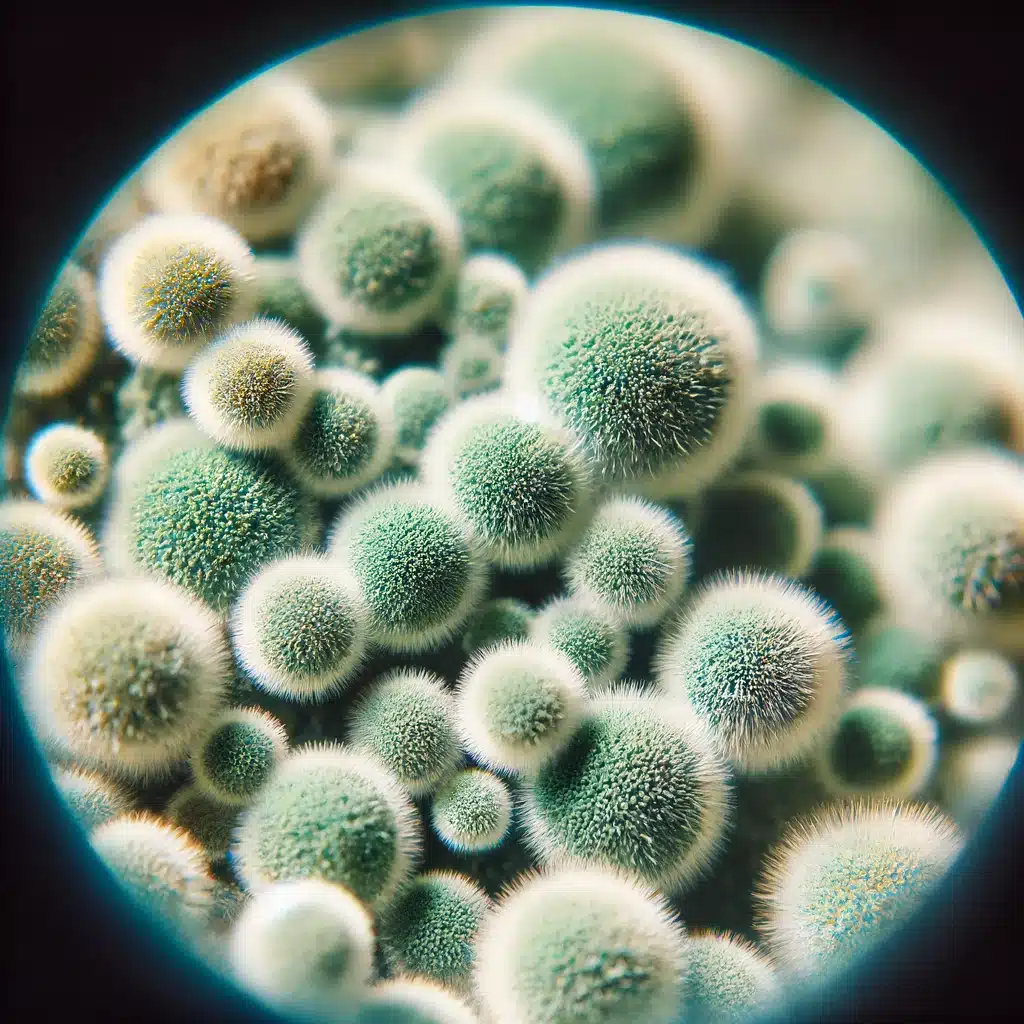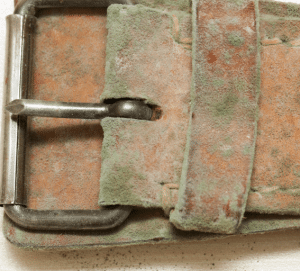Mold spores are microscopic, airborne particles that serve as the reproductive units of mold fungi. These tiny spores are ubiquitous in nature and can be found virtually everywhere, both indoors and outdoors.
While they play a crucial role in the natural decomposition process, their presence in our living spaces can pose significant health risks.
Mold spores are tough and can survive in many harsh conditions, including extreme temperatures and low moisture levels. Even after being exposed to disinfectants, they can remain dormant for long periods.
However, once they find a suitable environment with moisture and organic materials, they can become active and start growing. If you’re worried about mold in your home, it’s essential to consider mold testing services to ensure your space is safe and healthy.
The ability of mold spores to spread and colonize new areas is remarkable. They can travel through air currents, attach themselves to clothing, pets, or other surfaces, and even hitch a ride on dust particles.
This makes it challenging to completely eliminate them from indoor environments, especially if there are ongoing moisture issues or sources of organic matter.
The Health Risks of Mold Spores
While not all mold spores are inherently harmful, exposure to certain types and concentrations can have adverse effects on human health.
The severity of these effects can vary depending on several factors, including the type of mold present, the duration of exposure, and an individual’s sensitivity or existing health conditions.
Some common health risks associated with mold spore exposure include:
Respiratory problems
- Allergic reactions, such as sneezing, coughing, and wheezing
- Asthma attacks or exacerbation of asthma symptoms
- Lung inflammation and difficulty breathing
Skin irritation
- Rashes, itching, or skin irritation upon direct contact with mold spores
Immune system suppression
- Weakened immune response, making individuals more susceptible to other illnesses
Neurological effects
- Headaches, dizziness, and cognitive impairment in some cases
Mycotoxin exposure
- Certain mold species produce toxic substances called mycotoxins, which can cause various health problems if ingested or inhaled in significant quantities.
Common Sources of Mold Spores
Mold spores can originate from various sources, both indoors and outdoors. Understanding these sources is crucial for identifying potential mold problems and taking appropriate preventive measures.
Outdoor sources
- Soil, decaying leaves, and other organic matter
- Plants, trees, and vegetation
- Construction sites or areas with disturbed soil
Indoor sources
- Damp or water-damaged areas (e.g., basements, bathrooms, kitchens)
- Leaks in roofs, walls, or plumbing
- Condensation on windows or surfaces
- Poorly ventilated areas with high humidity
- Flooding or water intrusion incidents
- Inadequate drying of building materials after water damage
Signs of Mold Spores in Your Home
While mold spores themselves are invisible to the naked eye, there are several signs that may indicate their presence in your home. Being aware of these signs can help you identify potential mold issues and take prompt action.
Musty or earthy odors
A persistent, unpleasant smell that is often described as musty, damp, or earthy can be an indicator of mold growth.
Visible mold growth
Discolored patches, fuzzy or slimy growths, or greenish-black spots on surfaces like walls, ceilings, or floors are clear signs of mold.
Water stains or moisture problems
Persistent water stains, condensation, or moisture issues can create an ideal environment for mold growth.
Respiratory symptoms
If you or your family members experience persistent respiratory problems, such as coughing, wheezing, or difficulty breathing, it could be a sign of mold spore exposure.
Allergy-like symptoms
Unexplained symptoms like sneezing, runny nose, itchy eyes, or skin irritation may be related to mold spore exposure.
How Mold Spores Affect Indoor Air Quality
Maintaining good indoor air quality (IAQ) is essential for a healthy home. Mold spores can harm IAQ, causing health issues like allergies and respiratory problems.
When mold spores are in the air, they can be inhaled and trigger these problems, especially for those with weak immune systems or existing conditions. A thorough mold inspection is key to identifying and removing mold in your home.
Certain molds produce VOCs and mycotoxins, which worsen air quality and cause issues like headaches and dizziness. Mold can also make asthma and COPD symptoms worse.
To keep IAQ healthy, promptly address mold growth with mold inspection and effective remediation strategies. Regular air quality testing can help catch mold issues early.
How to Test for Mold Spores
If you suspect the presence of mold spores in your home or workspace, it is essential to conduct proper testing to identify the type and concentration of mold present.
Various testing methods are available, each with distinct advantages and limitations.
Air sampling
- Air sampling involves collecting air samples using specialized equipment, such as spore traps or air pumps.
- These samples are then analyzed in a laboratory to identify the types and concentrations of mold spores present.
- Air sampling provides a comprehensive assessment of the overall indoor air quality.
Surface sampling
- Surface sampling involves collecting samples from suspected mold-contaminated surfaces using specialized swabs or tape lifts.
- These samples are analyzed to identify the specific types of mold present on those surfaces.
- Surface sampling is useful for pinpointing localized mold growth areas.
Bulk sampling
- Bulk sampling involves collecting physical samples of materials suspected of being contaminated with mold, such as drywall, insulation, or carpet.
- These samples are analyzed to determine the presence and types of mold within the materials.
- Bulk sampling is often used in conjunction with air or surface sampling to provide a comprehensive assessment.
Preventing Mold Spores: Tips for a Mold-Free Home
While it is nearly impossible to completely eliminate mold spores from indoor environments, there are several steps you can take to prevent their growth and minimize their impact on your home and health.
Control moisture levels
- Maintain relative humidity levels between 30% and 50% in your home.
- Use dehumidifiers in damp areas like basements or bathrooms.
- Quickly take care of any water leaks or moisture problems.
Improve ventilation
- Make sure to provide proper ventilation in areas where moisture tends to accumulate, like bathrooms, kitchens, and laundry rooms.
- Turn on exhaust fans or open windows to improve air circulation.
Maintain cleanliness
- Regularly clean and disinfect surfaces to prevent mold growth.
- Promptly remove any standing water or moisture sources.
- Dry wet areas and materials within 24-48 hours to prevent mold growth.
Inspect and maintain HVAC systems
- Regularly clean and replace air filters in your heating, ventilation, and air conditioning (HVAC) systems.
- Ensure proper maintenance and cleaning of ductwork and air handling units.
Limit indoor plants
- While plants can improve indoor air quality, they can also contribute to moisture buildup if overwatered.
- Be mindful of plant placement and watering practices.
Consider mold-resistant materials
- When renovating or building, consider using mold-resistant materials, such as certain types of drywall, paints, or flooring.
Frequently Asked Questions
Can mold spores be completely eliminated from indoor environments?
While it is nearly impossible to completely eliminate mold spores from indoor environments, their growth and proliferation can be effectively controlled through proper moisture management, ventilation, and prompt remediation of any mold issues.
Maintaining low indoor humidity levels and addressing moisture sources are key to preventing mold growth and minimizing the risks associated with mold spore exposure.
Are all types of mold spores harmful to human health?
Not all types of mold spores are inherently harmful to human health. However, certain species of mold can produce mycotoxins or other compounds that can cause adverse health effects, particularly in individuals with compromised immune systems or respiratory conditions.
It is important to identify the specific type of mold present and assess the potential risks based on its characteristics and concentration levels.
Can mold spores travel from outdoors into indoor spaces?
Yes, mold spores can easily travel from outdoor sources into indoor spaces through open windows, doors, ventilation systems, or on clothing and other materials.
While it is impossible to completely prevent outdoor mold spores from entering indoor environments, maintaining proper indoor humidity levels, and ventilation, and promptly addressing any moisture issues can help prevent their growth and proliferation indoors.
Conclusion
We understand the hidden dangers of mold spores and the impact they can have on your health and home. Our comprehensive mold testing services are designed to identify and address any mold issues you might have, ensuring a safe and healthy living environment for you and your family.
Don’t let mold spores compromise your indoor air quality and well-being. Our expert team uses the latest technology and methods to detect and manage mold growth effectively. With our thorough inspections, you can have peace of mind knowing that any mold presence will be swiftly identified and addressed.
Choose Mold Testing Houston for reliable and professional mold testing services. We’re here to help you maintain a healthy home and protect your loved ones from the potential hazards of mold. Contact us today to schedule your mold inspection and take the first step toward a mold-free home.





